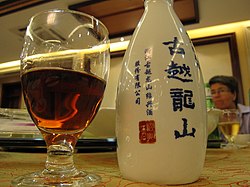This article needs additional citations for verification. (August 2011) |
| Huangjiu | |||||||||||
|---|---|---|---|---|---|---|---|---|---|---|---|
 A glass of Shaoxing wine, a variety of huangjiu | |||||||||||
| Simplified Chinese | 黄酒 | ||||||||||
| Traditional Chinese | 黃酒 | ||||||||||
| Hanyu Pinyin | huángjiǔ | ||||||||||
| Literal meaning | yellow wine | ||||||||||
| |||||||||||


Huangjiu (Chinese: 黃酒; lit. 'yellow wine') is a type of Chinese rice wine most popular in the Jiangnan area. Huangjiu is brewed by mixing steamed grains including rice, glutinous rice or millet with qū as starter culture, followed by saccharification and fermentation at around 13–18 °C (55–64 °F) for fortnights. Its alcohol content is typically 8% to 20%.
Huangjiu is usually pasteurized, aged, and filtered before its final bottling for sale to consumers. The maturation process can be complicated but important for the development of the layers of flavours and fragrance. A few brands of premium grade huangjiu could have been aged for up to 20 years. Although as huangjiu's name may suggest, its colour is typically light yellow and orange, but it can in fact range from clear to brown. Many famous huangjiu brands promote the quality of water used in brewing[1][2] in their advertising, and some consider it to be the most important ingredient.[3]
Huangjiu is commonly consumed warm, as the richness from the flavour compounds are released better when warm. In summer, it is popular to drink sweet huangjiu chilled or on ice. Liaojiu (料酒) is a type of huangjiu used in cooking, an example of this being the liaojiu-type of Shaoxing rice wine. Major producers of huangjiu include China and Taiwan.[2]
- ^ Huang, Faxin; Cai, David Tiande; Nip, Wai-Kit (2006). Y. H. Hui (ed.). 173 Chinese Wines: Jiu. Introductions to Chinese culture. Vol. 4. Taylor & Francis. pp. 353–404. ISBN 9781420026337. OCLC 70288640. Retrieved 24 October 2017.
{{cite book}}:|work=ignored (help) - ^ a b Li, Zhengping (2011). Chinese Wine. Cambridge University Press. ISBN 9780521186506. OCLC 769489216.
- ^ Huang, Cai & Nip 2006, p. 376, 397.